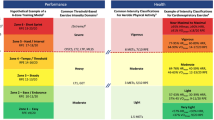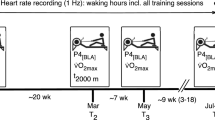Abstract
The two Yo-Yo intermittent recovery (IR) tests evaluate an individual’s ability to repeatedly perform intense exercise. The Yo-Yo IR level 1 (Yo-Yo IR1) test focuses on the capacity to carry out intermittent exercise leading to a maximal activation of the aerobic system, whereas Yo-Yo IR level 2 (Yo-Yo IR2) determines an individual’s ability to recover from repeated exercise with a high contribution from the anaerobic system. Evaluations of elite athletes in various sports involving intermittent exercise showed that the higher the level of competition the better an athlete performs in the Yo-Yo IR tests. Performance in the Yo- Yo IR tests for young athletes increases with rising age. The Yo-Yo IR tests have shown to be a more sensitive measure of changes in performance than maximum oxygen uptake. The Yo-Yo IR tests provide a simple and valid way to obtain important information of an individual’s capacity to perform repeated intense exercise and to examine changes in performance.

















Similar content being viewed by others
References
Bangsbo J. The physiology of soccer-with special reference to intense intermittent exercise. Acta Physiol Scand 1994; 15 Suppl. 619: 1–156
Bangsbo J, NØrregaard L, ThorsØe F. Activity profile of competition soccer. Can J Sports Sci 1991 Jun; 16 (2): 110–6
Ekblom B. Applied physiology of soccer. Sports Med 1986 Jan–Feb; 3 (1): 50–60
Krustrup P, Mohr M, Ellingsgaard H, et al. Physical demands of elite female soccer games: importance of training status. Med Sci Sports Exerc 2005; 37 (7): 1242–8
Krustrup P, Mohr M, Steensberg A, et al. Muscle and blood metabolites during a soccer game: implications for sprint performance. Med Sci Sports Exerc 2006; 38 (6): 1165–74
Mayhew SR, Wenger HA. Time-motion analysis of professional soccer. J Hum Movement Stud 1985; 11: 49–52
McInnes SE, Carlson JS, Jones CJ, et al. The physiological load imposed on basketball players during competition. J Sports Sci 1995; 13: 387–97
Mohr M, Krustrup P, Bangsbo J. Match performance of high standard soccer players with special reference to development of fatigue. J Sport Sci 2003 Jul; 21 (7): 519–28
Rienzi E, Drust B, Reilly T, et al. Investigation of antrophometric and work-rate profiles of elite South Americaninternational soccer players. J Sports Med Phys Fitness 2000 Jun; 40 (2): 162–9
Young WB, Newton RU, Doyle TL, et al. Physiological and anthropometric characteristics of starters and non-starters and playing positions in elite Australian Rules football: a case study. J Sci Med Sport 2005; 8 (3): 333–45
Léger LA, Lambert J. A maximal multistage 20-m shuttle run test to predict V?O2max. Eur J Appl Physiol 1982; 49: 1–12
Bangsbo J. Fitness training in football: a scientific approach. Bagsværd: HO+Storm, 1994
Castagna C, Abt G, D’Ottavio S. Competitive-level differences in Yo-Yo intermittent recovery and twelve minute run test performance in soccer referees. J Strength Cond Res 2005; 19 (4): 805–9
Krustrup P, Bangsbo J. Physiological demands of top class soccer refereeing in relation to physical capacity: effect of intense intermittent exercise training. J Sports Sci 2001; 19: 881–91
Krustrup P, Mohr M, Amstrup T, et al. The Yo-Yo intermittent recovery test: physiological response, reliability and validity. Med Sci Sports Exerc 2003 Apr; 35 (4): 697–705
Bangsbo J. The Yo-Yo tests [online]. Available from URL: (http://www.soccerfitness.com) [Accessed 2005]
Krustrup P, Mohr M, Nybo L, et al. The Yo-Yo IR2 test: physiological response, reliability, and application to elite soccer. Med Sci Sports Exerc 2006 Sep; 38 (9): 1666–73
Tong TK, Fu FH. Effect of specific inspiratory muscle warm-up on intense intermittent run to exhaustion. Eur J Appl Physiol 2006 Aug; 97 (6): 673–80
Oliveira J. Endurance evaluation in intermittent sports [dissertation]. Porto: Faculty of Sport Sciences and Physical Education, University of Porto, 2000
Barbero Alvarez JC, Barbero Alvarez V. Efectos del entrenamieno durante una pretemporada en la potencia maxima aerobica medida dos test de campo progresivos, uno continuo y otro intermitente. Granada: Departamento de Educacion Fisica Y Deportiva, Facultad de Educacion y Humanidades de Melilla,Universidad de Granada [online]. Available from URL: (http://www.futbolrendimiento/comar/Download/Pretemporada.pdf) [Accessed 2007 Nov 15]
Carvalho C, Roriz-de-Oliveira P, Carvalho A. Analysis of different parameters of physical condition for footballers in relation to their positional role [abstract]. J Sports Sci 2004 Jun; 22 (6): 531–2
Castagna C, Impellizzeri FM, Chamari K, et al. Aerobic fitness and Yo-Yo continuous and intermittent tests performances in soccer players: a correlation study. J Strength Cond Res 2006 May; 20 (2): 320–5
Ferrari Bravo D, Rampinini E, Impellizzeri FM. et al. Effect of repeated sprints versus aerobic interval training in soccer players [abstract]. In: Hoppeler H, Reilly T, Tsolakidis E, et al.,editors. 11th annual Congress of the European College ofSport Science; 2006 Jul 5-8; Lausanne. Cologne: Sportverlag Strauss, 2006: 319
Hasegawa H. et al. Changes of jump squat power and its relationship with sprint speed, agility, and intermittent endurance during the preseason and the first part of the in-season in professional football league players in Japan [abstract]. In: Aagaard P, Madsen K, Magnusson P, et al., editors. Strength training for sport, health, aging and rehabilitation. 5th International Conference on Strength Training; 2006 Oct 18-21; Odense: University of Southern Denmark, 2006: 245–6
Kirkendall DT. Physiology of soccer. In: Garrett WE, Kirkendall DT, editors. Exercise and sport science. Philadelphia (PA): Lippincott, Williams & Wilkins, 2000: 875–84
Kirkendall DT, Leonard K, Garret Jr WE. On the relationship between fitness and running volume and intensity in female soccer players [abstract]. J Sports Sci 2004 Jun; 22 (6): 549–50
McHughes M, Bangsbo J, Lexell J. Principles of rehabilitation following sports injuries: sports-specific performance testing. In: Kjær M, Krogsgarrd M, Magnusson P, et al., editors. Textbook of sports medicine. Oxford: Blackwell Science, 2003: 201–25
Neto L, Nunes C, Hespanhol J, et al. Physiological and anthro pometric characteristics of junior Brazilian soccer players [abstract]. J Sports Sci 2004 Jun; 22 (6): 554–5
Rampinini E, Impellizzeri FM, Castagna C, et al. Factors influencing physiological responses to small-sided soccer games. J Sports Sci 2007; 25 (6): 659–66
Atkins SJ. Performance of the Yo-Yo intermittent recovery test by elite professional and semiprofessional rugby league players. J Strength Cond Res 2006 Feb; 20 (1): 222–5
Thomas A, Dawson B, Goodman C. The Yo-Yo test: reliability and association with a 20-m run and V? O2max. Int J Sports Physiol Perf 2006; 1: 137–49
Iaia FM, Kolding H, Gunnarsson T, et al. Change to anaerobic training improves running economy and high intensity exercise performance in endurance runners [abstract]. In: Hoppeler H, Reilly T, Tsolakidis E, et al., editors. 11th annual Congress of the European College of Sport Science; 2006 Jul 5-8; Lausanne. Cologne: Sportverlag Strauss, 2006: 212–3
Bangsbo J, Mohr M, Krustrup P. Physical and metabolic demands of training and match-play in the elite football player. J Sports Sci 2006; 24 (7): 665–74
Bangsbo J. Aerobic and anaerobic training in soccer: with special emphasis on training of youth players-fitness training in soccer I. Bagsværd: HO+Storm, 2006
Balsom PD, Wood K, Olsson P, et al. Carbohydrate intake and multiple sprint sports: with special reference to football (soccer). Int J Sports Med 1999; 20 (1): 48–52
Balsom PD, Gaitanos GC, SØderlund K, et al. High-intensity exercise and muscle glycogen availability in humans. Acta Physiol Scand 1999; 165: 337–45
Bangsbo J, NØrregaard L, ThorsØe F. The effect of carbohydrate diet on intermittent exercise performance. Int J Sports Med 1992; 13 (2): 152–7
Weston M, Helsen W, MacMahon C, et al. The impact of specific high-intensity training sessions on football referees’ fitness levels. Am J Sports Med 2004 Jan–Feb; 32 (1 Suppl.): 54S–61S
Ferrari Bravo D. Capacita` di ripetere sprint nel calcio: aspetti fisiologici, valutazione e allenamento [dissertation]. Milan: Faculty of Exercise Sciences, State University of Milan, 2006
Mohr M, Krustrup P, Bangsbo J. Seasonal changes in physiological parameters of elite soccer players [abstract]. Med Sci Sports Exerc 2002; 36 (5): 24
Todd MK, Scott D, Chisnall PJ. Fitness characteristics of English female soccer players: an analysis by position and playing standard. In: Spinks W, Reilly T, Murphy A, editors. Science and football IV. London: E & FN Spon, 2002: 374–81
Mohr M, Bangsbo J. Development of fatigue towards the end of a high level soccer match [abstract]. Med Sci Sports Exerc 2001; 33 (5): 215
Mohr M, Krustrup P, Nielsen JJ, et al. Effect of two different intense training regimes on skeletal muscle ion transport proteins and fatigue development. Am J Physiol Regul Integr Comp Physiol 2007; 292 (4): R1594–602
Bangsbo J, Mohr M, Poulsen A, et al. Training and testing the elite athlete. J Exerc Sci Fitness 2006; 4 (1): 1–14
Author information
Authors and Affiliations
Corresponding author
Rights and permissions
About this article
Cite this article
Bangsbo, J., Iaia, F.M. & Krustrup, P. The Yo-Yo Intermittent Recovery Test. Sports Med 38, 37–51 (2008). https://doi.org/10.2165/00007256-200838010-00004
Published:
Issue Date:
DOI: https://doi.org/10.2165/00007256-200838010-00004




